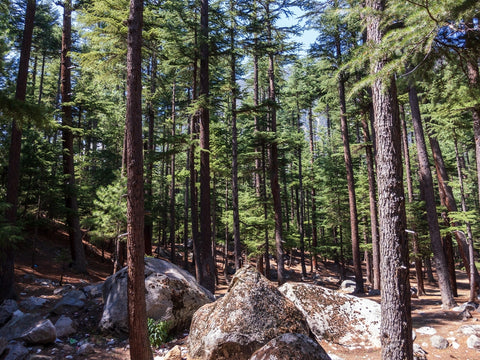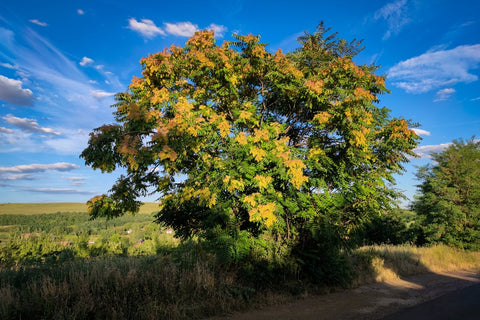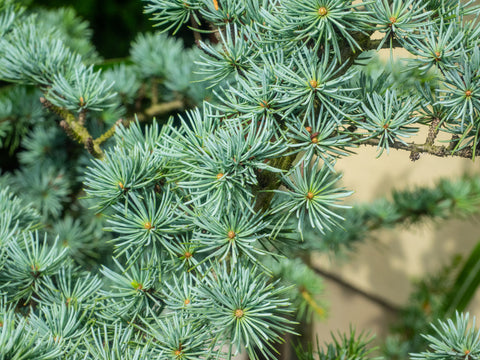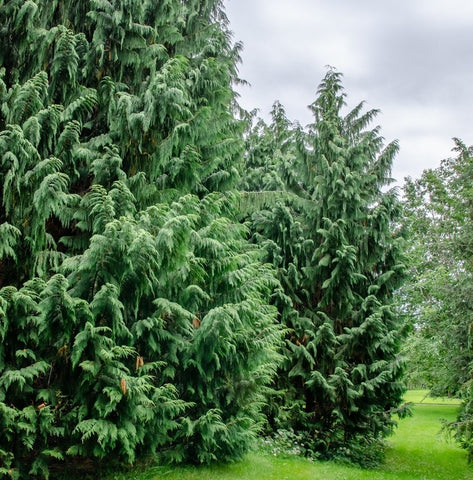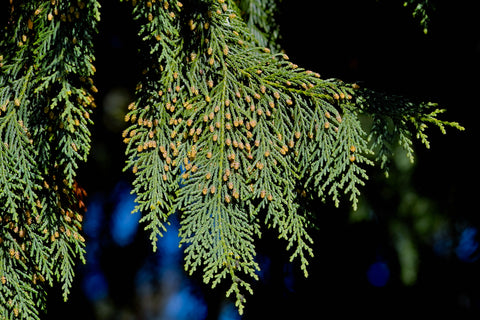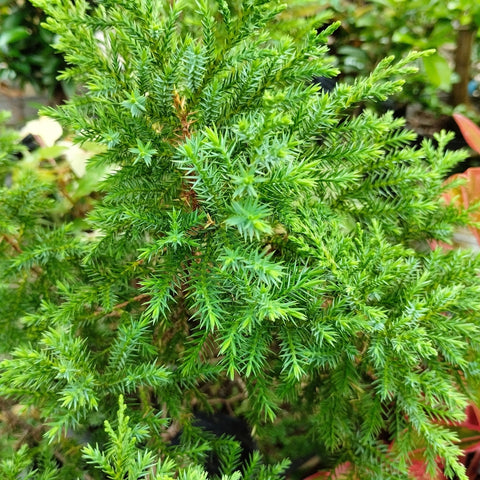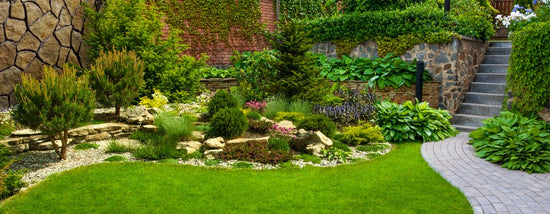Cedar trees are often admired for their striking beauty and versatility. They are native to the western Himalayas and the Mediterranean region.
Many know of their fragrance and durability, but few know about the wide array of species.
From the aromatic red cedar to the majestic deodar tree, these evergreen trees are very diverse and possess all kinds of qualities that we will explore in this article.
➲Cedar Trees: Qualities and Characteristics
Cedar trees, renowned for their many qualities, hail from the Himalayan and Mediterranean regions. However, different species of cedar trees also have different origins.
Regardless of their varied origins, they have a few qualities in common that make them beloved around the world. 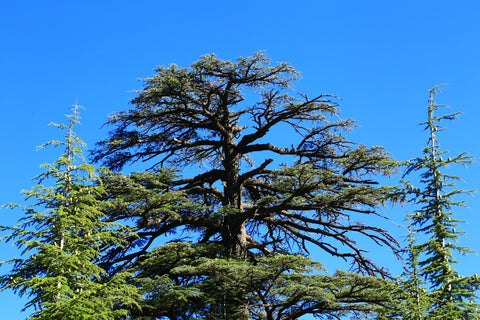
✯Natural Insect-repellent:
Cedar trees produce a scent that is fragrant and also acts as a natural insect-repellent.
✯Durability:
Cedar wood's exceptional durability and resistance to decay, all thanks to its natural oils, ensure that cedar products last, making them a popular choice for outdoor applications.
✯Versatility:
This wood's fine-grained texture makes it easy to work with and lends itself to polished finishes. Cedar's low shrinkage and stability reduce warping tendencies, enhancing its suitability for building projects.
✯Noise Reduction:
Cedar wood can provide effective noise reduction, making it a suitable material for applications like acoustic panels and sound barriers.
✯Historical and Cultural Significance:
Cedar trees often hold cultural and historical significance in different regions around the world. They have been used in traditional ceremonies, rituals, and symbolism, representing qualities like strength, resilience, and timelessness.
➲True and "False" Cedar Trees:
♦True cedars, or "Cedrus" species, belong to the Cedrus genus and are part of the Pinaceae family.
They include the Cedar of Lebanon (Cedrus libani), the Atlas Cedar (Cedrus atlantica), and the Deodar Cedar (Cedrus deodara), among others.
These cedars are known for their aromatic wood and fine-grained timber.
♦"False cedars" typically refer to other coniferous trees that are not part of the Cedrus genus but may resemble true cedars in some ways.
For example, trees like the Eastern Red Cedar (Juniperus virginiana), the Western Red Cedar (Thuja plicata), and the White Cedar (Thuja occidentalis) are often called "false cedars."
These species belong to the Cupressaceae family, and while they may share certain characteristics with true cedars, they are categorically distinct.
➲Varieties and types: The different types of cedar trees
✦Eastern Red Cedar (Juniperus virginiana):
The Eastern Red Cedar, also known as Juniperus virginiana, is a native American cedar species.
Its wood is widely known for having a reddish tinge and is very often used in woodworking, including the crafting of cedar chests.
Its aromatic scent also makes it a popular choice for landscaping.
✦Deodar Tree (Cedrus deodara):
The Deodar tree, scientifically named Cedrus deodara, is renowned for its graceful, drooping branches and needle-like leaves.
Originating from the Himalayan region, it is often referred to as the "tree of the gods."
Deodar trees are an important part of many gardens, providing shade and an exotic touch.
✦White Cedar Tree (Thuja occidentalis):
The White Cedar tree, scientifically known as Thuja occidentalis, are very well known for their elegant, fan-shaped foliage.
These trees can thrive in various soil types and are commonly used for ornamental hedges and windbreaks.
White Cedar plant is highly resistant to various diseases and pests, making it a low-maintenance and hardy choice for landscaping.
✦Western Red Cedar (Thuja plicata):
The Western Red Cedar, Thuja plicata, is a large evergreen tree found mainly in the Pacific Northwest.
Its rich, reddish wood is often in-demand for construction and crafting purposes. It's also a vital part of the local ecosystem.
It provides wildlife habitat, stabilizes the soil around it, improves water quality, enhances biodiversity, and holds cultural significance.
Its presence fosters healthy ecosystems and enriches the environment, benefiting both nature and humans.
✦Spanish Cedar (Cedrela odorata):
Spanish cedar, named Cedrela odorata scientifically, is native to tropical regions in the Americas.
It's known for its fine-grained, aromatic wood, which is used in making furniture, cabinets, and cigar boxes.
✦Atlas Cedar (Cedrus atlantica):
The Atlas Cedar, or Cedrus atlantica, is native to the Atlas Mountains of Morocco and Algeria.
Its beautiful, silvery-blue needles and majestic growth make it an excellent choice for landscaping and as an ornamental tree.
The wood of the Atlas Cedar is highly prized, and the species has historical significance, having been used for construction in ancient times.
It symbolizes strength and endurance in its native region and has become a beloved tree in various parts of the world.
✦Alaska Cedar (Cupressus nootkatensis):
The Alaska Cedar, scientifically known as Cupressus nootkatensis, thrives in the Pacific Northwest and Alaska.
Its aromatic wood is used for construction and boat building, and it adds a touch of elegance to gardens.
Alaska Cedars play a vital role in its local ecosystems by providing habitat for wildlife and contributing to the natural beauty of the region.
These adaptable trees are a symbol of resilience and have cultural significance in native cultures.
✦Incense Cedar (Calocedrus decurrens):
Incense Cedar, or Calocedrus decurrens, is valued for its fragrant wood, which has been traditionally used for incense.
It is also a popular choice for fencing and decking due to its resistance to decay.
Its unique scent, fine-grained texture, and minimal warping properties have endeared it to woodworkers and craftsmen, while also contributing to its continued popularity in various industries.
✦Cedar of Lebanon (Cedrus libani):
The Cedar of Lebanon, or Cedrus libani, is an iconic cedar species associated with great historical and cultural significance.
Its strong and durable wood has been used in the construction of ancient temples, ships, and various other structures.
Even today, the Cedar of Lebanon stands as a symbol of national pride, strength, and resilience, highlighting its enduring cultural and ecological importance.
✦Yellow Cedar (Cupressus nootkatensis):
Yellow Cedar, a variant of the Alaska Cedar (Cupressus nootkatensis), is distinguished by its yellowish wood. It also has differently shaped leaves that can be scaly and rather prickly.
It's highly valued for its resilience and beauty, used in boat building and furniture making.
Indigenous cultures in the Pacific Northwest have a deep connection with the Yellow Cedar. Traditionally, it has been used for crafting canoes, totem poles, and tools, preserving cultural heritage.
✦Port Orford Cedar (Chamaecyparis lawsoniana):
This is a species of Cypress Trees native to the southwestern part of Oregon and northern California in the United States.
This evergreen tree is highly valued for its fine-grained, durable wood, making it a popular choice in the timber industry.
Its wood is used for various purposes, including construction, boat building, and outdoor applications.
However, it faces conservation concerns due to habitat loss and the spread of root disease, which makes its management and preservation important.
✦Siberian Pine (Pinus sibirica):
The Siberian Pine (Pinus sibirica) is a significant coniferous tree native to the Siberian taiga and other parts of Russia and Mongolia. It is one of the "false" cedar types.
It is known for its long, slender pine needles and production of edible pine nuts, which have nutritional and economic value.
The tree's wood is used in construction, and its resin has various applications.
Siberian Pine forests support local wildlife and play a crucial role in the northern ecosystems, contributing to regional biodiversity.
✦Bermuda Cedar (Juniperus bermudiana):
The Bermuda Cedar (Juniperus bermudiana) is a coniferous tree native to Bermuda. It is a symbol of the island's natural heritage and cultural identity.
These evergreen trees feature a distinctive, fragrant wood with a reddish tinge.
Unfortunately, the species has faced significant challenges due to overharvesting, habitat loss, and introduced pests.
Conservation constant efforts are being made to protect and restore these iconic trees, emphasizing their cultural and ecological significance for Bermuda.
Whether you take a deeper look at the true or the false cedars, they all are all given extreme cultural and regional importance. Their presence in their respective local ecosystems are very beneficial and contribute greatly to wildlife and human life.
Buy plants online with Ugaoo to start your journey with healthier, sustainable living!


